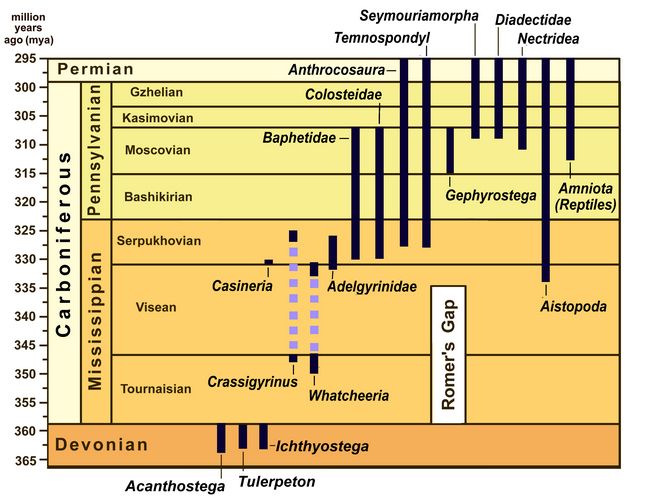Athena Review Image Archive ™
Romers Gap

Romer's Gap (after Smithson et a. 2012)
"Romer's Gap" is named for the paleontologist Alfred Romer (1956), who described a discontinuity in the fossil record between vertebrates at the end of the Devonian period, with its high diversity of fishes, and low density of fossil assemblages of both fish and tetrapods in the early Carboniferous (Mississippian period). Romer's gap (ca. 360-335 mya) corresponds to the last few million years of the Devonian period, and the first 15-20 million years of the Mississippian (Tournaisian and Visean stages).
Several lines of evidence tend to confirm Romer's observations. A major extinction event at the end of the Devonian reduced most surviving marine and freshwater groups to a few lineages. Before the event, oceans and lakes were dominated by lobe-finned fishes and armored fishes called placoderms. After the gap, modern ray finned fish, as well as sharks and their relatives, became the dominant forms. The period also saw the demise of the Ichthyostegalia, early fish-like tetrapods with more than five digits, named for the type genus Ichthyostega (Coates et al. 2008).
Evidence for a sharp reduction in marine fishes at the start of Romer's Gap is also seen in an equivalent rise, during the same period, in hard-shelled crinoid echinoderms which were previously the chief prey of shell-crushing predator fish. When the number of shell-crushing ray-finned fishes and sharks increased later in the Carboniferous, coincident with the end of Romer's gap, the diversity of crinoids with Devonian-type protective shells fell sharply (Kammer and Ausitch 2006).
Several recent finds of early tetrapods including Pederpes and Whatcheeria from the period 347-340 mya have helped fill in this gap.)
References:
Benton, M.J. 2004. Vertebrate Paleontology. Blackwell Publishers.
Carroll, R. L. 1988. Vertebrate Paleontology and Evolution, WH Freeman & Co.
Coates et al. 2008
Kammer and Ausitch 2006
Romer, A.S. 1956. Osteology of the Reptiles. University of Chicago Press, Chicago.
.Copyright © 1996-2020 Rust Family Foundation (All Rights Reserved).